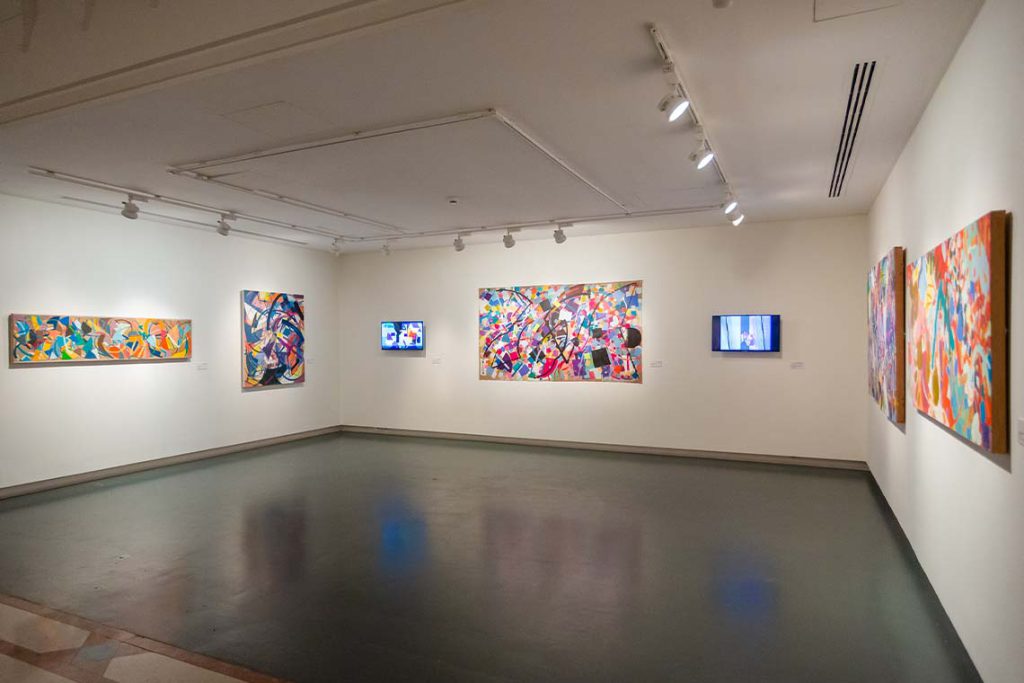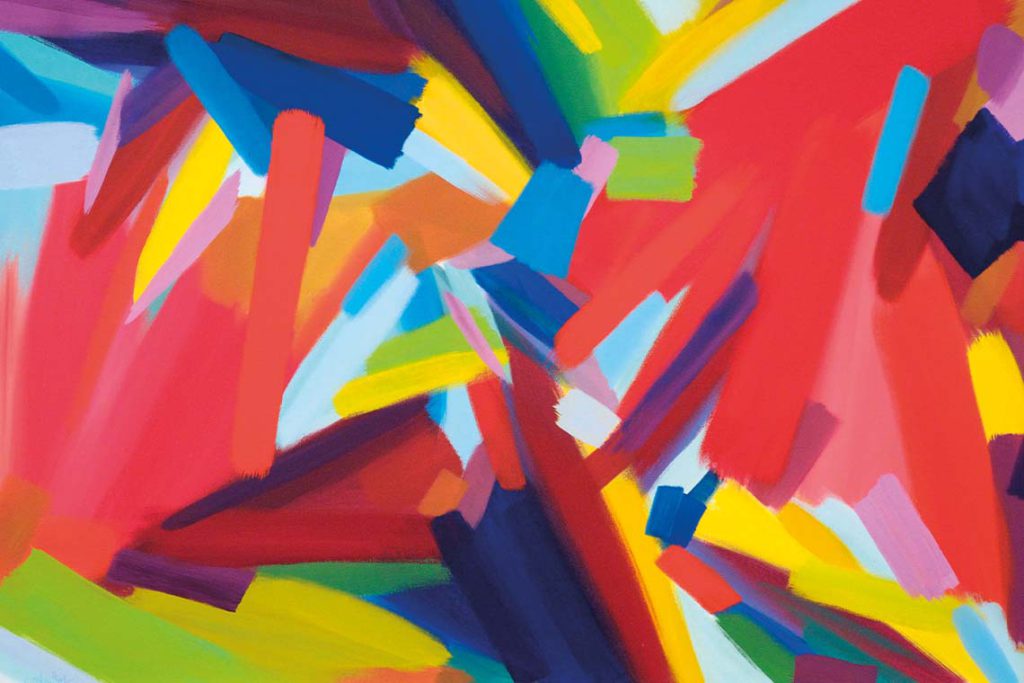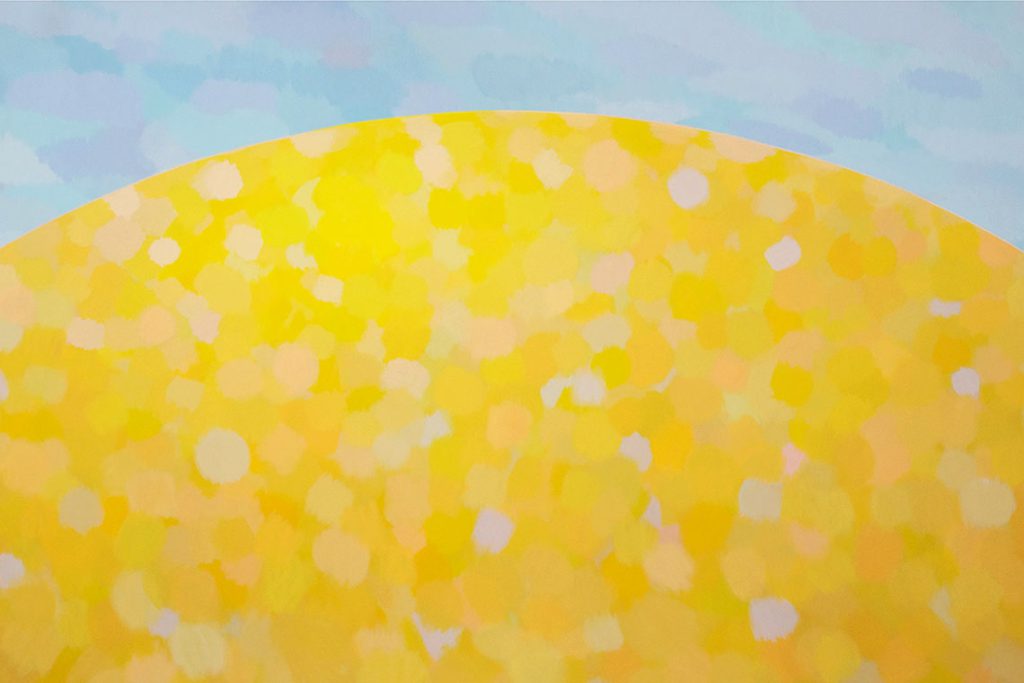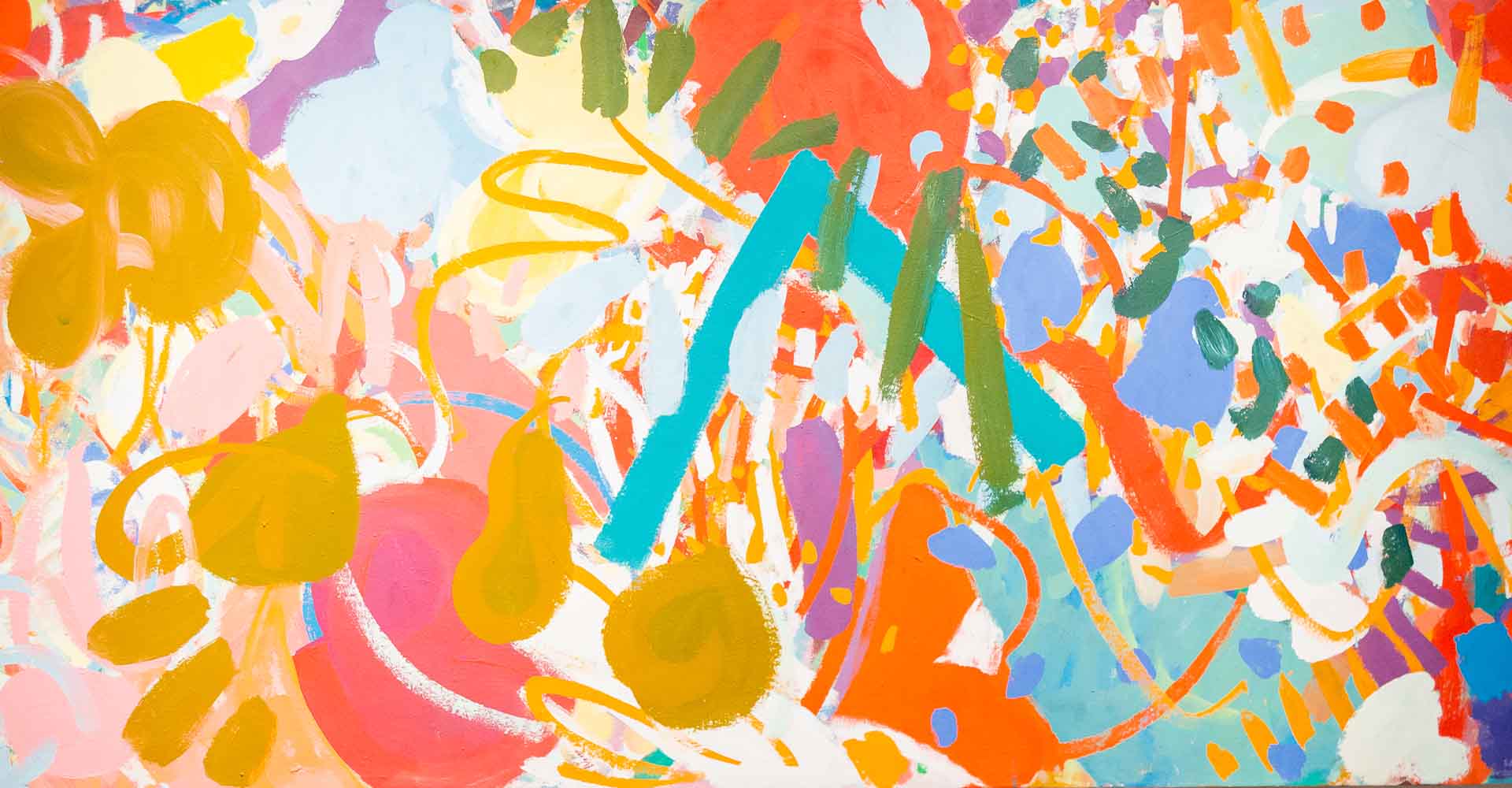Although Samia Halaby’s first Middle Eastern retrospective Lasting Impressions, on view at Sharjah Art Museum, highlights little-known aspects of her practice, the lack of political focus feels like a missed opportunity.
In Samia Halaby’s vast painting The Martyrdom of Talal (2012), a woman crouches in a garden, holding a small boy in her arms – his face twisted in pain – as behind her a young woman and an old man fall to the ground. While the scene unfolds across more than half of the 3.7-metre-wide canvas, the painting’s focal point is the much smaller figure of a man emerging from a doorway opposite. Out of scale with the other figures, he seems to shrink visibly, his face skeletal, mouth helplessly open, eyes disbelieving. He is based on Shaker Abdallah Easa, a victim – along with his family and 44 other Palestinian villagers – of the Kafr Qassem massacre of 29 October 1956.
On view in Lasting Impressions: Samia Halaby, the artist’s retrospective at Sharjah Art Museum (SAM), the painting is part of a body of work developed between 1999 and 2012 and which viscerally documents the nightmarish murders of the inhabitants of Kafr Qassem – men, women and children – in multiple “waves” by Israeli soldiers on the evening the Second Arab-Israeli war broke out. Rendered in stark black and white, the drawings and paintings depict villagers held at gunpoint, mass graves of bodies and children hiding from soldiers, while the wall texts list the names of the victims and recount the events of each wave of killing, based on oral testimonies and written reports collected by Halaby.

Unrestrained and meticulous in its level of detail, Halaby’s chronicle of the massacre is grimly resonant with the times. Like the social media documentation of Israel’s present bombardment of Gaza and attacks on the West Bank, it seeks to make visible a reality that has been denied historically through the settler colonial narrative perpetuated by the Israeli government and its Western allies. Halaby began the project in the late 1990s when Aishy Amer, a friend she met on the internet, invited her to visit the homes of Amer’s extended family in Kafr Qassem. “Aishy insisted that every Palestinian artist had a duty to make at least one painting about the Kafr Qassem massacre,” Halaby tells Canvas. Her initial sketches grew into a website commemorating the 50th anniversary of the massacre in 2006 and, eventually, a book that was published in 2016. “It was all together a huge effort of study and investigation that included questioning the real function of documentary pictorial art and its relationship to abstraction,” she recalls.
Documentary art is not typically associated with Halaby, whose vivid abstract works stand out in the popular imagination. Indeed, although displayed in a dedicated section, the Kafr Qassem works are found at the far end of the second hall that houses the exhibition within SAM. This room is one of a group of thematic displays of her work – including her kinetic paintings, olive tree drawings and Homage to Mona Saudi (1997) – that is curatorially distinguished from her abstract painting. In the rest of the space, the development of her abstraction is charted chronologically, from the 1960s to the present day. Near the entrance, the introductory wall text categorically highlights this distinction, claiming that she creates her documentary work addressing political subject matter by “placing aside for the time being her aspiration to add to the visual language of abstract painting”.

Yet, as Halaby herself suggests, documentary art bears an important relationship to abstraction – “the most political of any part of the arts,” she says. “It was born in the Soviet Revolution and still possesses those materialist attributes that distinguish the thinking of the Left from the idealism of conservatives.” In past interviews and writings, such as a 2019 essay entitled The Political Basis of Abstraction in the 20th Century as Explored by a Painter, she has argued against the idea that abstraction is born of personal feeling or ‘inner necessity’, but is, like all artistic renewals, a product of social and economic developments. She shows how movements such as Impressionism, Cubism, Futurism and Mexican muralism emerged from working-class revolutions.
In and of itself, the main abstraction-focused section of Lasting Impressions is curated beautifully, with the selection of works creating a visual narrative of the progression of Halaby’s art alongside her life. But the exhibition largely misses an important opportunity to reflect on the political dimensions of her abstraction – a considerable oversight in light of her lifelong outspoken activism. Her practice is famously influenced by the movements she discusses in The Political Basis of Abstraction, but this important point is strangely elusive in the show. Traces of the Futurist principle of ‘simultaneity’, for example, can be found in the period of her practice from 1988 to 1994 and which SAM entitles ‘A Picture Plane’, where “overlapping groups of events distinguished by colour become a rich abstract reflection of our life as we move through our house of the street or interact with people”.

This sense of movement is literalised in Halaby’s kinetic paintings, which she began around this period, experimenting with early Amiga coding platforms, and where the political significance is more explicitly acknowledged. One work from 1987, dedicated to Soviet Constructivist Olga Rozanova, is accompanied by a quote from Halaby reflecting on her artistic contributions “in the atmosphere of revolutionary creativity” of early 20th century Russia. Others refer to Halaby’s own anti-Zionist politics, such as Land (1988), consisting of shapes that expand, contract and collide with other shapes in a commentary on the political and social powers exercised over the ownership of land and its division. Her stance is more obliquely referenced in the titles of recent works such as Jerusalem, My Home (2014), which pays tribute to the Dome of the Rock, and Six Golden Heroes (2022), which “commemorates the amazing escape of six Palestinians from a high security Israeli prison,” she says.
This period also marked the zenith of her early activism in New York, fuelled by the eruption of the First Intifada. By day she would participate in cultural events and demonstrations, returning to her studio at night to paint. She discusses this experience in a video interview that opens the exhibition, but we do not learn more about the revolutionary spirit that galvanised her work. “The fellowship of advanced people led me to new aesthetic places. I felt free to explore and experiment,” she tells Canvas. “Abstraction being the art of revolution, born in revolution, born of revolutionary ethics, was normal to leftists bitten by the spirit of the Intifada. It seems that the invigorating effect of revolutionary thought is like a tsunami that lifts all disciplines of thought and the arts among them.”
Lasting Impressions: Samia Halaby runs until 7 January 2024



